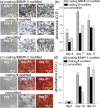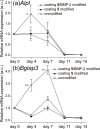Osteogenic Surface Modification Based on Functionalized Poly-P-Xylylene Coating
- PMID: 26379273
- PMCID: PMC4574780
- DOI: 10.1371/journal.pone.0137017
Osteogenic Surface Modification Based on Functionalized Poly-P-Xylylene Coating
Abstract
The biotechnology to immobilize biomolecules on material surfaces has been developed vigorously due to its high potentials in medical applications. In this study, a simple and effective method was designed to immobilize biomolecules via amine-N-hydroxysuccinimide (NHS) ester conjugation reaction using functionalized poly-p-xylylene coating on material surfaces. The NHS ester functionalized coating is synthesized via chemical vapor deposition, a facile and solvent-less method, creating a surface which is ready to perform a one-step conjugation reaction. Bone morphogenetic protein 2 (BMP-2) is immobilized onto material surfaces by this coating method, forming an osteogenic environment. The immobilization process is controlled at a low temperature which does not damage proteins. This modified surface induces differentiation of preosteoblast into osteoblast, manifested by alkaline phosphatase (ALP) activity assay, Alizarin Red S (ARS) staining and the expression of osteogenic gene markers, Alpl and Bglap3. With this coating technology, immobilization of growth factors onto material surface can be achieved more simply and more effectively.
Conflict of interest statement
Figures






References
-
- Karageorgiou V, Meinel L, Hofmann S, Malhotra A, Volloch V, Kaplan D. Bone morphogenetic protein-2 decorated silk fibroin films induce osteogenic differentiation of human bone marrow stromal cells. Journal of Biomedical Materials Research Part A. 2004;71A(3):528–37. 10.1002/jbm.a.30186 - DOI - PubMed
Publication types
MeSH terms
Substances
LinkOut - more resources
Full Text Sources
Other Literature Sources
Miscellaneous

